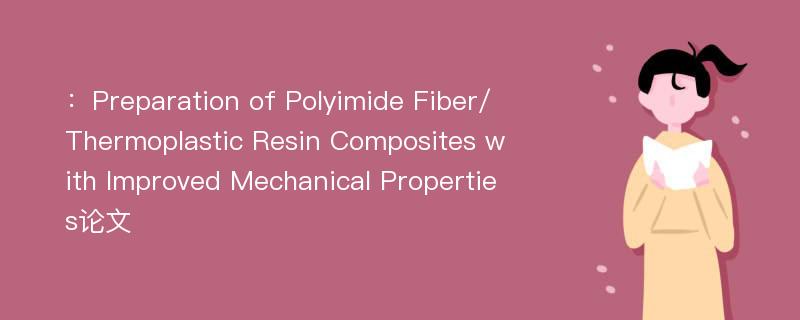
本文主要研究内容
作者(2019)在《Preparation of Polyimide Fiber/Thermoplastic Resin Composites with Improved Mechanical Properties》一文中研究指出:As a high-performance material for preparing composite materials, polyimide fibers suffer from many potential drawbacks, including poor bonding with other substrates, which results in composite materials with poor mechanical properties. Therefore, this study proposed a simple and rapid technique for obtaining loose, porous polyimide fiber papers by implementing a wet method using equal amounts of polyimide fiber and polyimide fiber paper as reinforcements, respectively. The polyimide resin-based composite materials were prepared by hand lay-up and hot pressing. The results showed that the paper-based reinforcement exhibited high porosity and the fibers were arranged with a uniform pore size distribution. The tensile properties, bending performance, and interlaminar shear performance of the paper-based composite improved by 130%, 108%, and 34.5%, respectively, compared to those of the fiberbased counterpart. The factors affecting the mechanical properties of the composites were analyzed based on the fiber length, fiber beating or lack thereof, and the basis weight of the paper. The increased uniformity of the polyimide fiber paper changed the ordering of the fibers and resolved drawbacks such as difficult dispersion, uneven pore size distribution, and poor mechanical properties related to single fibers in the resin-based composite material.
Abstract
As a high-performance material for preparing composite materials, polyimide fibers suffer from many potential drawbacks, including poor bonding with other substrates, which results in composite materials with poor mechanical properties. Therefore, this study proposed a simple and rapid technique for obtaining loose, porous polyimide fiber papers by implementing a wet method using equal amounts of polyimide fiber and polyimide fiber paper as reinforcements, respectively. The polyimide resin-based composite materials were prepared by hand lay-up and hot pressing. The results showed that the paper-based reinforcement exhibited high porosity and the fibers were arranged with a uniform pore size distribution. The tensile properties, bending performance, and interlaminar shear performance of the paper-based composite improved by 130%, 108%, and 34.5%, respectively, compared to those of the fiberbased counterpart. The factors affecting the mechanical properties of the composites were analyzed based on the fiber length, fiber beating or lack thereof, and the basis weight of the paper. The increased uniformity of the polyimide fiber paper changed the ordering of the fibers and resolved drawbacks such as difficult dispersion, uneven pore size distribution, and poor mechanical properties related to single fibers in the resin-based composite material.
论文参考文献
论文详细介绍
论文作者分别是来自Paper and Biomaterials的,发表于刊物Paper and Biomaterials2019年03期论文,是一篇关于,Paper and Biomaterials2019年03期论文的文章。本文可供学术参考使用,各位学者可以免费参考阅读下载,文章观点不代表本站观点,资料来自Paper and Biomaterials2019年03期论文网站,若本站收录的文献无意侵犯了您的著作版权,请联系我们删除。
